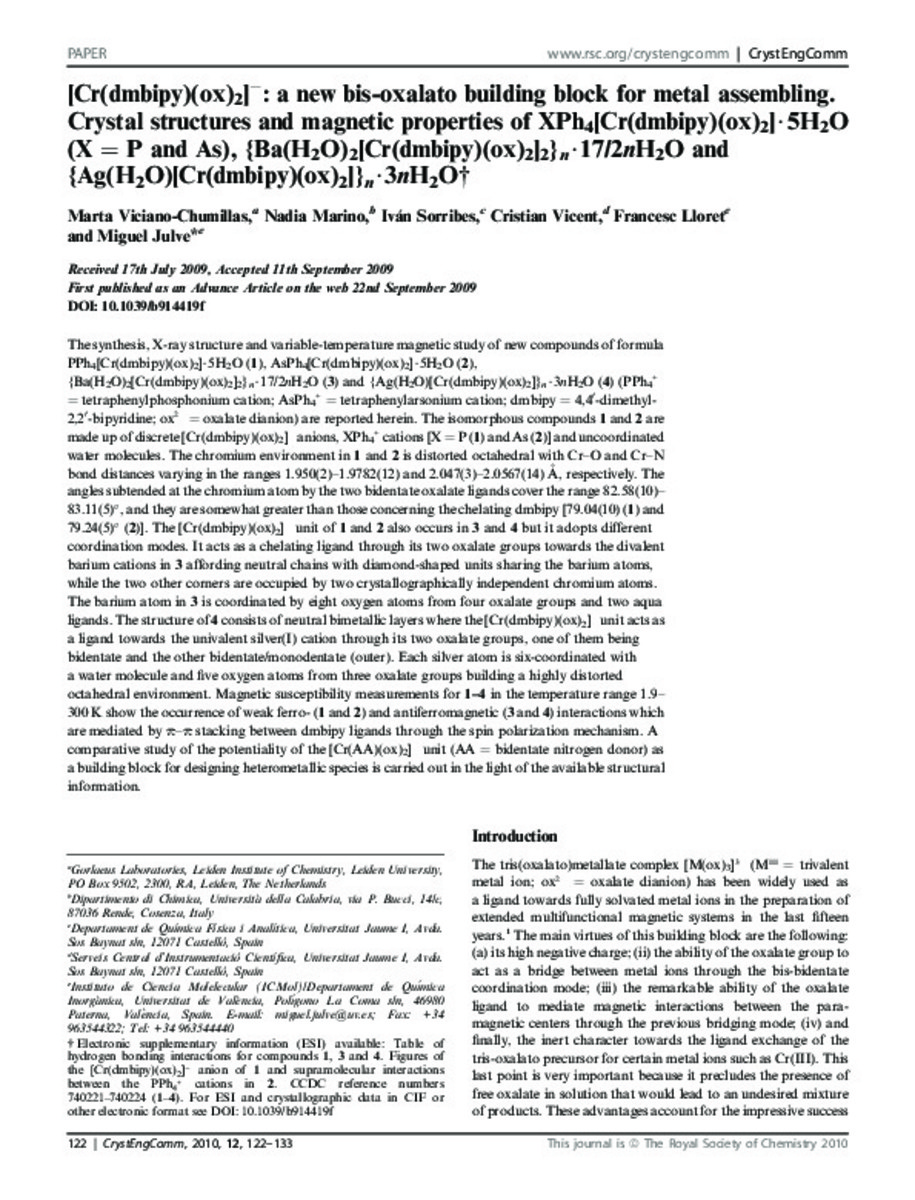Mostrar el registro sencillo del ítem
[Cr(dmbipy)(ox)2]−: a new bis-oxalato building block for metal assembling. Crystal structures and magnetic properties of XPh4[Cr(dmbipy)(ox)2]·5H2O (X = P and As), {Ba(H2O)2[Cr(dmbipy)(ox)2]2}n·17/2nH2O and {Ag(H2O)[Cr(dmbipy)(ox)2]}n·3nH2O
| dc.contributor.author | Viciano Chumillas, Marta | |
| dc.contributor.author | Marino, Nadia | |
| dc.contributor.author | Sorribes, Iván | |
| dc.contributor.author | Vicent Barrera, Cristian | |
| dc.contributor.author | Lloret Pastor, Francesc | |
| dc.contributor.author | Julve, Miguel | |
| dc.date.accessioned | 2012-03-23T07:43:58Z | |
| dc.date.available | 2012-03-23T07:43:58Z | |
| dc.date.issued | 2010 | |
| dc.identifier.citation | CrystEngComm (2010) vol. 12, p. 122-133 | |
| dc.identifier.issn | 1466-8033 | |
| dc.identifier.uri | http://hdl.handle.net/10234/33736 | |
| dc.description.abstract | The synthesis, X-ray structure and variable-temperature magnetic study of new compounds of formula PPh4 [Cr(dmbipy)(ox)2 ]$5H2O (1), AsPh4 [Cr(dmbipy)(ox)2 ]$5H2O (2), {Ba(H2O)2[Cr(dmbipy)(ox)2]2}n$17/2nH2O (3) and {Ag(H2O)[Cr(dmbipy)(ox)2]}n$3nH2O (4) (PPh4 + ¼ tetraphenylphosphonium cation; AsPh4 + ¼ tetraphenylarsonium cation; dmbipy ¼ 4,4 0 -dimethyl- 2,2 0 -bipyridine; ox 2 ¼ oxalate dianion) are reported herein. The isomorphous compounds 1 and 2 are made up of discrete [Cr(dmbipy)(ox)2] anions, XPh4 + cations [X ¼ P (1) and As (2)] and uncoordinated water molecules. The chromium environment in 1 and 2 is distorted octahedral with Cr–O and Cr–N bond distances varying in the ranges 1.950(2)–1.9782(12) and 2.047(3)–2.0567(14) A˚ , respectively. The angles subtended at the chromium atom by the two bidentate oxalate ligands cover the range 82.58(10)– 83.11(5) , and they are somewhat greater than those concerning the chelating dmbipy [79.04(10) (1) and 79.24(5) (2)]. The [Cr(dmbipy)(ox)2] unit of 1 and 2 also occurs in 3 and 4 but it adopts different coordination modes. It acts as a chelating ligand through its two oxalate groups towards the divalent barium cations in 3 affording neutral chains with diamond-shaped units sharing the barium atoms, while the two other corners are occupied by two crystallographically independent chromium atoms. The barium atom in 3 is coordinated by eight oxygen atoms from four oxalate groups and two aqua ligands. The structure of 4 consists of neutral bimetallic layers where the [Cr(dmbipy)(ox)2] unit acts as a ligand towards the univalent silver(I) cation through its two oxalate groups, one of them being bidentate and the other bidentate/monodentate (outer). Each silver atom is six-coordinated with a water molecule and five oxygen atoms from three oxalate groups building a highly distorted octahedral environment. Magnetic susceptibility measurements for 1–4 in the temperature range 1.9– 300 K show the occurrence of weak ferro- (1 and 2) and antiferromagnetic (3 and 4) interactions which are mediated by p–p stacking between dmbipy ligands through the spin polarization mechanism. A comparative study of the potentiality of the [Cr(AA)(ox)2] unit (AA ¼ bidentate nitrogen donor) as a building blo | |
| dc.format.extent | 12 p. | |
| dc.format.mimetype | application/pdf | |
| dc.language.iso | eng | |
| dc.publisher | Royal Society of Chemistry | |
| dc.rights.uri | http://rightsstatements.org/vocab/CNE/1.0/ | * |
| dc.subject | [Cr(dmbipy)(ox)2] | |
| dc.subject | Building block | |
| dc.subject | Crystal structure | |
| dc.title | [Cr(dmbipy)(ox)2]−: a new bis-oxalato building block for metal assembling. Crystal structures and magnetic properties of XPh4[Cr(dmbipy)(ox)2]·5H2O (X = P and As), {Ba(H2O)2[Cr(dmbipy)(ox)2]2}n·17/2nH2O and {Ag(H2O)[Cr(dmbipy)(ox)2]}n·3nH2O | |
| dc.type | info:eu-repo/semantics/article | |
| dc.rights.holder | © Royal Society of Chemistry | |
| dc.identifier.doi | http://dx.doi.org/10.1039/b914419f | |
| dc.rights.accessRights | info:eu-repo/semantics/openAccess | |
| dc.relation.publisherVersion | http://pubs.rsc.org/en/content/articlepdf/2010/ce/b914419f?page=search | |
| dc.type.version | info:eu-repo/semantics/publishedVersion |
Ficheros en el ítem
Este ítem aparece en la(s) siguiente(s) colección(ones)
-
QFA_Articles [812]
Articles de publicacions periòdiques







